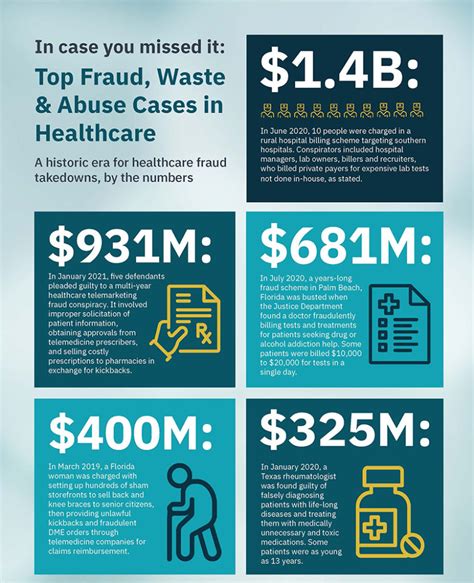Medical Insurance Fraud

Medical insurance fraud is a complex and pervasive issue that has far-reaching consequences for healthcare systems, insurance providers, and patients alike. This form of fraud involves deliberate deception and manipulation aimed at exploiting vulnerabilities in the healthcare industry for personal gain. With rising healthcare costs and an increasingly complex insurance landscape, understanding and combating medical insurance fraud has become more critical than ever.
In this comprehensive article, we delve into the intricate world of medical insurance fraud, exploring its various facets, impact, and the measures being taken to address it. Through real-world examples, industry insights, and data-driven analysis, we aim to provide a deeper understanding of this challenging issue and its implications.
The Dark Side of Healthcare: Understanding Medical Insurance Fraud

Medical insurance fraud is a multi-faceted issue that encompasses a wide range of deceptive practices. From exaggerated claims to outright fabrication of medical conditions, fraudsters employ various tactics to exploit the healthcare system. Understanding the different types of fraud and the underlying motivations is crucial to developing effective strategies for prevention and detection.
Types of Medical Insurance Fraud
Medical insurance fraud can be categorized into several distinct types, each with its unique characteristics and methods.
- Provider Fraud: This involves healthcare providers, such as doctors, nurses, or pharmacists, who submit false or inflated claims to insurance companies. It may include billing for services not rendered, upcoding procedures to receive higher reimbursement, or billing for more expensive treatments than those actually provided.
- Patient Fraud: Patients themselves can also engage in fraudulent activities. This includes exaggerating symptoms, faking injuries or illnesses, or submitting claims for services they never received. Some patients may also use false identities or alter medical records to gain access to treatments or medications.
- Pharmacy Fraud: Pharmacy fraud often involves the illegal distribution of prescription drugs or the submission of fraudulent claims for medications. This can include dispensing fake or counterfeit drugs, forging prescriptions, or submitting claims for medications not actually dispensed.
- Billing Fraud: Billing fraud encompasses various schemes to manipulate billing processes. This may involve unbundling services (billing separately for components of a single service), double billing (charging twice for the same service), or upcoding (assigning a higher billing code to increase reimbursement).
Each type of fraud presents unique challenges and requires tailored approaches for detection and prevention. By understanding the specific tactics employed, investigators and industry professionals can develop more effective strategies to combat fraud.
Motivations Behind Medical Insurance Fraud
The motivations behind medical insurance fraud are diverse and often intertwined. While financial gain is a primary driver, other factors such as addiction, desperation, or a sense of entitlement can also play a role.
- Financial Gain: The promise of easy money is a significant motivator for many fraudsters. By submitting false claims or manipulating billing processes, individuals or organized criminal groups can profit from the healthcare system at the expense of legitimate patients and providers.
- Addiction: In some cases, individuals may engage in fraud to obtain prescription drugs for personal use or resale. This is particularly prevalent with controlled substances, where individuals may fake symptoms or alter medical records to gain access to addictive medications.
- Desperation: For some patients, the high cost of healthcare can lead to desperate measures. This may involve falsifying claims to receive necessary treatments or medications that they otherwise cannot afford.
- Sense of Entitlement: In certain instances, individuals may feel entitled to benefits or services that they believe they deserve but cannot obtain through legitimate means. This sense of entitlement can drive them to engage in fraudulent activities to gain access to desired treatments or medications.
Understanding the underlying motivations can help healthcare professionals and law enforcement develop targeted interventions and support systems to address the root causes of fraud.
The Impact of Medical Insurance Fraud

The consequences of medical insurance fraud extend far beyond the immediate financial losses incurred by insurance providers. The impact is felt across the entire healthcare ecosystem, affecting patients, providers, and the overall quality of care.
Financial Implications
Medical insurance fraud results in significant financial losses for insurance companies, which ultimately lead to higher premiums for all policyholders. According to industry estimates, the cost of medical insurance fraud in the United States alone is estimated to be billions of dollars annually.
| Year | Estimated Cost of Medical Insurance Fraud (USD) |
|---|---|
| 2021 | $150 billion |
| 2022 | $160 billion (projected) |

These losses not only impact insurance companies but also contribute to rising healthcare costs, making insurance premiums unaffordable for many individuals and families.
Healthcare Access and Quality
Fraudulent activities can disrupt the flow of resources within the healthcare system, leading to reduced access to care for legitimate patients. When insurance companies experience financial losses due to fraud, they may respond by tightening eligibility criteria or reducing coverage, making it harder for honest policyholders to access necessary treatments.
Additionally, medical insurance fraud can compromise the quality of care. Fraudulent claims may result in inaccurate medical records, leading to misdiagnoses or inappropriate treatments. This not only affects the patient's health outcomes but also erodes trust in the healthcare system.
Impact on Providers
Healthcare providers, especially those who operate on tight margins, can be severely affected by medical insurance fraud. When insurance companies deny legitimate claims due to fraud detection or reduce reimbursement rates, providers may struggle to maintain their financial viability. This can lead to reduced access to care, particularly in underserved areas where healthcare services are already limited.
Combating Medical Insurance Fraud: Strategies and Innovations
Addressing the complex issue of medical insurance fraud requires a multi-faceted approach involving collaboration between healthcare providers, insurance companies, law enforcement agencies, and government bodies. Here, we explore some of the strategies and innovations being employed to combat fraud and protect the integrity of the healthcare system.
Enhanced Data Analytics and Technology
Advancements in data analytics and technology have played a pivotal role in the fight against medical insurance fraud. By leveraging powerful data mining and machine learning techniques, insurance companies and investigators can identify patterns and anomalies that may indicate fraudulent activities.
For instance, advanced analytics can detect unusual billing patterns, such as high volumes of similar claims from a single provider or suspicious coding practices. By flagging these anomalies, investigators can prioritize investigations and allocate resources more effectively.
Moreover, technology-based solutions, such as blockchain, are being explored to enhance the security and transparency of healthcare data. Blockchain technology can help ensure the integrity of medical records, reducing the risk of fraudulent alterations and providing a more reliable basis for claim adjudication.
Collaborative Efforts and Information Sharing
Combating medical insurance fraud requires a collaborative approach involving various stakeholders. Insurance companies, healthcare providers, and law enforcement agencies are increasingly working together to share information and resources. By pooling their expertise and data, they can identify fraud trends, develop targeted prevention strategies, and bring fraudsters to justice.
Information sharing platforms and databases are being established to facilitate the exchange of critical data, such as provider profiles, claim histories, and known fraud schemes. These platforms enable real-time updates and allow for more efficient detection and response to emerging fraud threats.
Education and Awareness
Education and awareness play a crucial role in preventing medical insurance fraud. By informing patients, providers, and the general public about the risks and consequences of fraud, we can foster a culture of integrity and accountability.
Insurance companies and healthcare providers can educate their policyholders and patients about common fraud schemes and the importance of accurate and honest reporting. Providing clear guidelines and resources can empower individuals to recognize and report suspicious activities, contributing to a more robust fraud detection system.
Strengthening Regulatory Frameworks
A robust regulatory framework is essential to deter and punish medical insurance fraud effectively. Governments and regulatory bodies play a critical role in establishing and enforcing laws and regulations aimed at combating fraud. These frameworks should be regularly reviewed and updated to address emerging fraud trends and technologies.
Furthermore, collaboration between regulatory bodies and industry stakeholders is vital to ensure that regulations are practical, effective, and aligned with the evolving nature of fraud.
Future Implications and Challenges
As we continue to navigate the complex landscape of medical insurance fraud, several key challenges and opportunities emerge. Understanding these future implications is crucial for shaping effective strategies and policies to address fraud.
Emerging Technologies and Fraud Risks
The rapid advancement of technology presents both opportunities and challenges in the fight against medical insurance fraud. While advanced analytics and technology-based solutions offer powerful tools for fraud detection, they also present new vulnerabilities.
As healthcare data becomes increasingly digitized and interconnected, the risk of cyberattacks and data breaches rises. Fraudsters may exploit these vulnerabilities to access sensitive information, manipulate records, or launch large-scale fraud schemes. Therefore, ensuring the security and integrity of healthcare data systems is critical to mitigating these risks.
Global Collaboration and Information Exchange
Medical insurance fraud is not limited by geographical boundaries. As healthcare systems become more interconnected globally, collaboration and information exchange between countries become increasingly important. Sharing best practices, intelligence, and resources can help identify and disrupt international fraud networks.
However, achieving effective global collaboration presents its own set of challenges, including varying regulatory frameworks, cultural differences, and language barriers. Overcoming these obstacles requires a coordinated effort and the development of standardized protocols for information sharing and cooperation.
Balancing Fraud Detection and Patient Privacy
While robust fraud detection systems are essential, it is equally important to protect patient privacy and maintain trust in the healthcare system. Striking the right balance between detecting fraud and respecting patient confidentiality is a delicate task.
As healthcare providers and insurance companies employ more sophisticated data analytics and surveillance techniques, they must ensure that patient privacy is protected and that any personal information collected is used solely for legitimate purposes. This requires careful consideration of ethical guidelines and the implementation of robust data protection measures.
Conclusion

Medical insurance fraud is a complex and ever-evolving issue that demands our attention and proactive measures. By understanding the various types of fraud, their impact, and the strategies being employed to combat them, we can work towards a more resilient and secure healthcare system.
As we continue to navigate the challenges posed by medical insurance fraud, collaboration, innovation, and a commitment to integrity will be key. By working together and leveraging the power of technology and data, we can protect the interests of patients, providers, and insurance companies, ensuring a fair and sustainable healthcare ecosystem for all.
How can patients recognize and report medical insurance fraud?
+Patients play a crucial role in identifying and reporting medical insurance fraud. They should be vigilant for any unusual billing practices, such as charges for services not received or discrepancies in their insurance statements. Patients can report suspected fraud to their insurance provider’s fraud hotline or to local law enforcement agencies. Additionally, staying informed about common fraud schemes and educating themselves about their rights and responsibilities can empower patients to recognize and report fraudulent activities.
What measures are insurance companies taking to prevent fraud?
+Insurance companies employ various strategies to prevent and detect medical insurance fraud. They utilize advanced data analytics and machine learning algorithms to identify suspicious billing patterns and anomalies. Additionally, they collaborate with healthcare providers, law enforcement agencies, and government bodies to share information and intelligence about fraud trends. Insurance companies also invest in education and awareness campaigns to help policyholders recognize and report fraud.
How does medical insurance fraud impact healthcare costs for consumers?
+Medical insurance fraud contributes significantly to rising healthcare costs for consumers. When insurance companies experience financial losses due to fraud, they may increase premiums for all policyholders to offset these losses. Additionally, fraud can lead to reduced access to care and compromised quality, further impacting patients’ ability to afford necessary treatments and medications.



